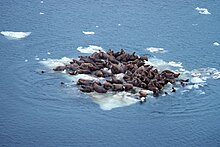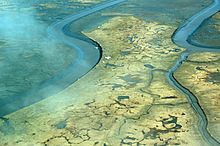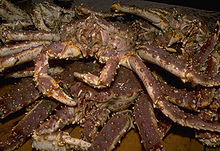Bering Sea
It covers over 2,000,000 square kilometers (770,000 sq mi) and is bordered on the east and northeast by Alaska, on the west by the Russian Far East and the Kamchatka Peninsula, on the south by the Alaska Peninsula and the Aleutian Islands and on the far north by the Bering Strait, which connects the Bering Sea to the Arctic Ocean's Chukchi Sea.
Most scientists think that during the most recent ice age, sea level was low enough to allow humans to migrate east on foot from Asia to North America across what is now the Bering Strait.
This is commonly referred to as the "Bering land bridge" and is accepted by most, though not all scientists, to be the first point of entry of humans into the Americas.
Warm water conditions in the summer of 1997 resulted in a massive bloom of low energy coccolithophorid phytoplankton (Stockwell et al. 2001).
A long record of carbon isotopes, which is reflective of primary production trends of the Bering Sea, exists from historical samples of bowhead whale baleen.
[19] Trends in carbon isotope ratios in whale baleen samples suggest that a 30–40% decline in average seasonal primary productivity has occurred over the last 50 years.
Other marine mammals include walrus, Steller sea lion, northern fur seal, orca and polar bear.
[22][23][24] Seabird species include tufted puffins, the endangered short-tailed albatross, spectacled eider, and red-legged kittiwakes.
[25][26] Many of these species are unique to the area, which provides highly productive foraging habitat, particularly along the shelf edge and in other nutrient-rich upwelling regions, such as the Pribilof, Zhemchug, and Pervenets canyons.
[35] The 2002 supernatural thriller, Ghost Ship, directed by Steve Beck, follows a marine salvage crew in the Bering Sea who discover the lost Italian ocean liner, Antonia Graza that disappeared in 1962.





